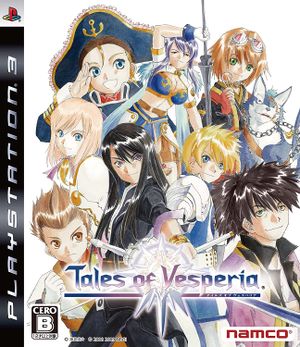{{vginfobox
|image =  |developer = Namco Tales Studio
|publisher = Bandai Namco Games
|series = Tales
|date = JP September 17, 2009
|developer = Namco Tales Studio
|publisher = Bandai Namco Games
|series = Tales
|date = JP September 17, 2009
|release = Multi-platform
|genre = Action, Role-playing
|modes = Single-player, Co-op
|gameid = BLJS10053
Tales of Vesperia is an action role-playing game set in a fantasy world featuring three-dimensional environments and characters. The game's environments are split into two types. On the field map, the main characters navigate reduced-scale environments. A compass and mini-map are displayed, along with towns, other named locations, and enemy icons. Striking an enemy icon triggers a battle, while interacting with a town causes the party to enter it. In battle and towns or similar locations, characters move around environments built on a lifelike scale relative to the human characters. In these areas, the party may interact with non-player characters. Within these environments, items such as crates can be moved by the currently assigned character. After a certain point in the game, an item called the Sorcerer's Ring is given to the party, enabling them to shoot bolts of energy. These bolts can be used to activate switches, move objects, and attack enemies from a distance. Save points can be found in dungeons and towns. Items such as equipment and weapons are purchased with Gald, the in-game currency. While in environments, players can trigger optional character conversations called Skits. In Skits, characters are represented by head-and-shoulder portraits, and the conversations can range from dramatic to comedic.
Characters have several different stats and gauges: their health, a magic meter stocked by Technical Points, and Learning Points for learning skills, raising a character's respective agility or luck, and how a character reacts to attacks. Attack types are physical and magical, while defense is limited to physical attacks. Characters gain experience levels through accumulating experience points. Experience Points and Gald is earned through battles, along with recovering a degree of Technical Points and occasionally items dropped by defeated enemies. Skills, attributes that change different stats, can be assigned to each character. The number of skills that can be assigned is calculated by the number of skill points each character has available. Battling with equipment associated with a particular skill enables that character to learn it when they have filled their Learning Points meter.[10] Cooking, creating meals with ingredients found in battle or around explored environments, can also be used by individual characters to restore their Health and Technical Points and grant temporary enhancements. Recipes are learned from a character called the Wonder Chef
The PlayStation 3 version of the game has two additional playable characters, new quests, new mini-games, redesigned areas, new artes, additional skits and full voice acting, amongst other improvements and changes over the Xbox 360 original release.
This version of the game was released exclusively in Japanese, however there is a fan translation available and is compatible with RPCS3.
Configuration
No options that deviate from RPCS3's default settings are recommended for this title.
Known Issues
There are no reported issues with this title.